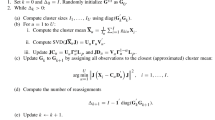Abstract
Very general multilinear models, called CANDELINC, and a practical least-squares fitting procedure, also called CANDELINC, are described for data consisting of a many-way array. The models incorporate the possibility of general linear constraints, which turn out to have substantial practical value in some applications, by permitting better prediction and understanding. Description of the model, and proof of a theorem which greatly simplifies the least-squares fitting process, is given first for the case involving two-way data and a bilinear model. Model and proof are then extended to the case ofN-way data and anN-linear model for generalN. The caseN = 3 covers many significant applications. Two applications are described: one of two-way CANDELINC, and the other of CANDELINC used as a constrained version of INDSCAL. Possible additional applications are discussed.
Similar content being viewed by others
Reference notes
Carroll, J. D., Green, P. E., & Carmone, F. J.CANDELINC: A new method for multidimensional analysis with constrained solutions. Paper presented at the meeting of the International Congress of Psychology, Paris, France, July 1976.
Carroll, J. D., & Pruzansky, S.MULTILINC: Multiway CANDELINC. Paper presented at the meeting of the American Psychological Association, San Francisco, August 1977.
Carroll, J. D. & Pruzansky, S.Use of LINCINDS as a rational starting configuration for INDSCAL. Unpublished memorandum, Bell Telephone Laboratories, 1979.
Cohen, H. S.Three-mode rotation to approximate INDSCAL structure. Paper presented at the annual meeting of the Psychometric Society, Palo Alto, California, March, 1974.
DeLeeuw, J. & Heiser, W.Multidimensional scaling with restrictions on the configuration. Proceedings of the Fifth International Symposium on Multivariate Analysis, Pittsburgh, June 1978.
Harshman, R. A. Foundations of the PARAFAC procedure; Models and conditions for an “explanatory” multi-modal factor analysis,UCLA Working Papers in Phonetics, 1970,16, 1–84.
Harshman, R. A. PARAFAC-2; mathematical and technical notes,UCLA Working Papers in Phonetics, 1972,22, 30–44.
Kruskal, J. B. & Carmone, F.How to use M-D-SCAL (Version 5M) and other useful information. Unpublished memorandum, Bell Telephone Laboratories, 1969.
Kruskal, J. B., Young, F. W., & Seery, J. B.How to use KYST, a very flexible program to do multidimensional scaling and unfolding. Unpublished memorandum, Bell Telephone Laboratories, 1973.
Noma, E., & Johnson, J.Constraining nonmetric multidimensional scaling configurations (Tech. Rep. 60). Ann Arbor: The University of Michigan, Human Performance Center, August 1977.
Tucker, L. R. & MacCallum, R. C. Personal communication, 1974.
References
Bentler, P. M., & Weeks, D. G. Restricted multidimensional scaling models,Journal of Mathematical Psychology, 1978,17, 138–151.
Bloxom, B. Constrained multidimensional scaling in N spaces.Psychometrika, 1978,43, 397–408.
Borg, I. & Lingoes, J. C. A model and algorithm for multidimensional scaling with external constraints on the distances.Psychometrika, 1980,45, 25–38.
Carroll, J. D. Individual differences and multidimensional scaling. In R. N. Shepard, A. K. Romney & S. Nerlove (Eds.),Multidimensional scaling theory and applications in the behavioral sciences (Vol. I). New York, Academic Press, 1972.
Carroll, J. D., & Chang, J. J. Analysis of individual differences in multidimensional scaling via an N-way generalization of “Eckart-Young” decomposition,Psychometrika, 1970,35, 283–320.
Carroll, J. D. & Wish, M. Multidimensional perceptual models and measurement methods. In E. C. Carterette & M. P. Friedman (Eds.).Handbook of perception. (Vol. II) Psychophysical judgement and measurement. New York: Academic Press, Inc., 1974, 391–447.
Eckart, C. & Young, G. The approximation of one matrix by another of lower rank,Psychometrika, 1936,1, 211–218.
Green, P. E. Carroll, J. D. & Carmone, F. J. Superordinate factorial designs in the analysis of consumer judgments.Journal of Business Research, 1976,4, 281–295.
Horan, C. B. Multidimensional scaling: Combining observations when individuals have different perceptual structures,Psychometrika, 1969,34, 139–165.
Johnson, R. M. Minimal transformation to orthonormality,Psychometrika, 1966,31, 61–66.
MacCallum, R. C. Effects of conditionality on INDSCAL and ALSCAL weights,Psychometrika, 1977,42, 297–305.
McGee, V. E. Multidimensional scaling of N sets of similarity measures: A nonmetric individual differences approach,Multivariate Behavioral Research, 1968,3, 233–248.
Torgerson, W. S.Theory and Methods of Scaling, New York: Wiley, 1958.
Tucker, L. The extension of factor analysis to three-dimensional matrices, In Frederiksen, N. & Gulliksen, H. (Eds.)Contributions to mathematical psychology. New York: Holt, Rinehart & Winston, 1964, 109–127.
Tucker, L. R. Relations between multidimensional scaling and three-mode factor analysis,Psychometrika, 1972,37, 3–27.
Wish, M. Subjects' expectations about their own interpersonal communication: A multidimensional approach,Personality and Social Psychology Bulletin, 1975,1, 501–504.
Wish, M. & Kaplan, S. J. Toward an implicit theory of interpersonal communication,Sociometry, 1977,40, 234–246.
Wold, H. Estimation of principal components and related models by iterative least squares, In Krishnaiah, P. R. (Ed.)Multivariate Analysis, New York: Academic Press, 1966, 391–420.
Author information
Authors and Affiliations
Rights and permissions
About this article
Cite this article
Douglas Carroll, J., Pruzansky, S. & Kruskal, J.B. Candelinc: A general approach to multidimensional analysis of many-way arrays with linear constraints on parameters. Psychometrika 45, 3–24 (1980). https://doi.org/10.1007/BF02293596
Received:
Revised:
Issue Date:
DOI: https://doi.org/10.1007/BF02293596




